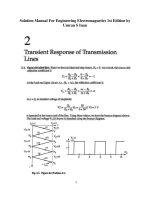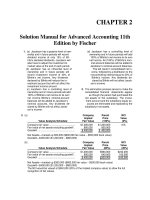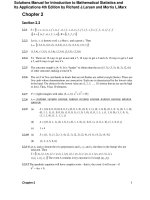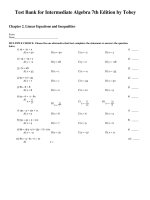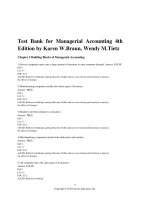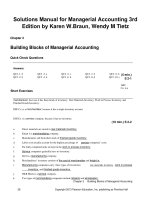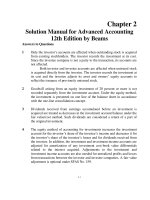Link full download solutions manual for managerial accounting 3rd edition by wendy m tietz and braun
Bạn đang xem bản rút gọn của tài liệu. Xem và tải ngay bản đầy đủ của tài liệu tại đây (877.08 KB, 41 trang )
Solutions Manual for Managerial Accounting 3rd
Edition by Karen W.Braun, Wendy M Tietz
Chapter 2
Building Blocks of Managerial Accounting
Quick Check Questions
Answers:
QC2 -1. b
QC2 -2. b
QC2 -3. a
QC2 -4. b
QC2 -5. c
QC2 -6. b
QC2 -7. b
QC2 -8. d
QC2 -9. b
QC2 -10. c
(5 min.)
S 2-1
ABC
Co. is a
Short Exercises
manufacturer, beca use it has three kinds of inventory: Raw Materials Inventory, Work in Process Inventory, and
Finished Goods Inventory .
DEF Co. is a merchandiser, because it has a single inventory account.
GHI Co. is a service company, because it has no inventory.
(10 min.) S 2-2
a.
Direct materials are stored in raw materials inventory.
b.
Kmart is a merchandising company.
c.
Manufacturers sell from their stock of finished goods inventory.
d.
Labor costs usually account for the highest percentage of
e.
Par tially completed units are kept in the work in process inventory.
f.
Service companies generally have no inventory.
g.
Intel is a manufacturing company.
h.
Merchandisers’ inventory consists of the cost of merchandise and freight in.
i.
Manufacturing companies carry three types of inventories:
service companies’ costs.
raw materials inventory , work in process
inventory, and finished goods inventory.
j.
H&R Block is a service company.
k.
Two types of merchandising companies include retailers and wholesalers.
Chapter 2 Building Blocks of Managerial Accounting
28
Copyright 2013 Pearson Education, Inc. publishing as Prentice Hall
(5-10 min.) S 2-3
a.
Produc tion
b.c. Customer Distributionserv
ice
d.
e.
f.
g.
Research and Development (R&D)
Marketing
Research and Development (R&D)
Production
h.
i.
j.
Design
Distribution
Production
(10 min.) S 2-4
a.
direct; trace
b.c. indirect;direct; trace allocate
d.
e.
f.
g.
direct; trace
direct; trace
indirect; allocate
direct; trace
h.
indirect; allocate
(5-10 min.) S 2-5 a. Inventoriable product cost
b.
c.
d.
e.
f.
g.
h.
i.
Inventoriable product cost
Period cost
Period cost
Inventoriable product cost
Inventoriable product cost
Period cost
Inventoriable product cost
Period cost
(5-10 min.) S 2-6
COST
a. Wages and benefits paid to assembly -line workers in the
manufacturing plant
b. Repairs and maintenance on factory equipment
c. Lease payment on administrative headquarters
d. Salaries paid to quality control inspectors in the plant
e. Property insurance – 40% of building is used for sales and
administration; 60% of building is used for manufacturing
f. Standard packaging materials used to package individual
units of product for sale ( e.g., cereal boxes in which
cereal is packaged)
g. Depreciatio n on automated production equipment
h. Telephone bills relating to customer service call center
Period Cost or
Inventoriable
Product Cost?
If an Inventoriable
Product Cost: Is it
DM, DL, or MOH?
Product
Product
Period
Product
DL
MOH
40% Period;
60% Product
—
MOH
Product
Product
Period
DM
MOH
Copyright 2013 Pearson Education, Inc. publishing as Prentice Hall
MOH
29
(5-10 min.) S 2-7
COST
1. Com pany president’s annual bonus
2. Plastic gallon containers in which milk is packaged
3. Depreciation on marketing department’s computers
4. Wages and salaries paid to machine operators at
dairy processing plant
5. Research and Development on improving milk pasteurization
process
6. Cost of milk purchased from dairy farmers
7. Lubricants used in running bottling machines
8. Depreciation on refrigerated trucks used to collect raw milk
from dairy farms
9. Property tax on dairy processing plant
10. Television advertisements for DairyPlains’ products
11. Gasoline used to operate refrigerated trucks used to
deliver finished dairy products to grocery stores
Period Cost or
Inventoriable
Product Cost?
Period
Product
Period (marketing
element of value
chain)
Product
Period (R&D
element of value
chain)
Product
Prod uct
Product
Product
Peri od
Period (distribution
element of value
chain)
If an Inventoriable
Product Cost: Is it
DM, DL, or MOH?
DM
DL
DM
MOH
MOH (part of the
cost of acquiring
DM)
MOH
(5 min.) S 2-8
F m P ’
Total Manufacturing Overhead Computation
Manufacturing overhea d:
Glue for picture frames*
Plant depreciation expense
Plant supervisor’s salary
Plant janitor’s salary
Oil for manufacturing equipment
Total manufacturing overhead
$
450
8,100
3,300
1,500
110
$13,460
*Assuming that it is not co st-effective to trace the low -cost glue to individual frames.
The following explanation is provided for instructional purposes, but it is not required.
Depreciation on company cars used by the sales force is a marketing expense, interest expense is a
finan cing expense, and the company president’s salary is an administrative expense. None of these expenses is
incurred in the manufacturing plant, so they are not part of manufacturing overhead.
The wood for frames is a direct material, not part of manufacturin
g overhead.
(5 min.) S 2-9
30
Copyright 2013 Pearson Education, Inc. publishing as Prentice Hall
Retailer
Cost of Goods Sold Computation
Cost of goods sold:
Beginning inventory
Purchases
Import duties
Freight -in
Cost of goods available for sale
Ending inventory
Cost of goods sold
$ 4,200
$42,000
1,100
3,600
46,700
50,900
(5,400 )
$45,500
(5-10 min.) S 2-10
Gossamer Secrets
Income Statement
Sales revenue
$39,330,000
Cost of goods sold:
Beginning inventory
$ 3,350,000
Purchases
Cost of goods available
23,975,000
for sale
27,325,000
Ending inventory
(4,315,000 )
Cost of goods sold
(23,010,000 )
Gross profit
16,290,000
Operating expenses
(6,150,000 )
Operating income
$ 10,140,000
(5 min.) S 2-11
Allterrain
Computation of Direct Materials Used
Direct materials used:
Beginning raw materials inventory
Purchases of direct materials
Import duties
Freight -in
Direct materials available for use
Ending raw materials invento ry
Direct materials used
$ 3,900
$15,600
900
600
Copyright 2013 Pearson Education, Inc. publishing as Prentice Hall
17,100
21,000
(2,000 )
$19,000
31
(5 min.) S 2-12
Robinson Manufacturing
Schedule of Cost of Goods Manufactured
Beginning work in process inventory
Add: Direct materials used
Direct labor
Manufacturing overhead
Total manufacturing costs incurred
during period
Total manufacturing costs to account for
Less: Ending work in process inventory
Cost of goods manufactured
$
78,000
$523,000
215,000
774,500
1,512,000
1,590,500
(84,000
$1,506,500
)
(10
min.) S 2-13
Relevant quantitative information might include:
•
Difference in benefits
•
Difference in costs of food
•
Difference in salaries
•
Difference in costs of transportation Difference in costs of housing
Relevant qualitative information might inclu de:
•
Difference in job description
•
Difference in lifestyle
•
Difference in future career development opportunities
•
Proximity to family and friends
•
Difference in weather
Relevant information always pertains to the future and differs between alternatives.
S tudent responses may vary.
(10 min.) S 2-14
a)
)
variable in most cases. In some cases, consumers are charged a flat monthly fee for water hook -up (fixed
portion of the bill), plus a fee for the amount of water used (variable portion of the bill). In such cases, the
monthly water bill would be a mixed cost.
b)
fixed or variable, depending on the cell phone plan. Plans that offer a set monthly fee for virtually unlimited
minutes are fixed because the cost stays constant over a wide range of minutes. Plans that charge a specified
rate per minute are variable.
c)
fixed
32
Copyright 2013 Pearson Education, Inc. publishing as Prentice Hall
d)
usually variable; fixed in some cities offering unlimited use with monthly passes.
e)
fixed
f)
fixed
g)
variable
Exercises (Group A)
(10 min.) E 2-15A
a.
Wholesalers buy products i n build from producers, mark them up, and resell them to retailers.
b.
Most for -profit organizations can be described as being in one (or more) of three categories:
merchandising, service, and manufacturing.
c.
Honda Motors converts raw materials invento ry into finished products.
d.
Inventory (merchandise) for a company such as Staples includes all of the costs necessary to purchase
products and get them onto the store shelves.
e.
Land’s End, Sears Roebuck & Co., and LL Bean are all examples of merchandising companies.
f.
An insurance company, a health care provider, and a bank are all examples of
g.
Work in process inventory is composed of goods partially through the manufacturing process (not
finished yet).
h.
Manufacturing companies report three types of inventory on a balance sheet.
i.
Service companies typically do not have an inventory account.
service companies .
(10-15 min.) E 2-16A
Reqs. 1 and 2
Radio Shack
Cost Classification
R&D
Research on
selling satellite
radio service
Purchases of
merchandise
Design
Purchases
Marketing
Distribution
Customer
Service
$ 600
$39,000
Copyright 2013 Pearson Education, Inc. publishing as Prentice Hall
33
Rearranging
store layout
Newspaper
advertisements
Depreciation
expense
on
delivery trucks
Payment to
consultant for
advice on
location of new
store
Freight-in
p
’ salaries
$700
$5,800
$1,100
2,100
3,700
4,300
Customer
complaint
department
Total
$2,700
$700
$42,700
$10,100
$1,100
$800
$800
(continued) E 2-16A
Req. 3
The total inventoriable product costs are
$42,700 .
(15 min.) E 2-17A
Reqs. 1, 2, and 3
Samsung Electronics
Cost Classification
Production
R&D
Design
Direct
Materials
Direct
Labor
Manufa cturing
Overhead Marketing
Salaries of
salespeople
Depreciation on
plant and equipment
Distribution
Customer
Service
$5
$70
Exterior case for
phone
Scientists’ salaries
Delivery expense
Chip set
Rearrange
production process
$6
$11
$ 8
$62
$ 1
Assembly
-line
workers’ wages
34
$12
Copyright 2013 Pearson Education, Inc. publishing as Prentice Hall
Technical support
hotline
1-800 (toll -free)
line for customer
orders
Total costs
$3
$11
$ 1
$68
$12
$70
5
$ 10
$ 8
$3
Req. 4
Total inventoriable product costs:
Direct materials……………………………………… $ 68 Direct
labor…………………………………………… 12
Manufacturing overhead……………………………
Total inventoriable produc t cost………………….
70
$150
Req. 5
The total prime cost is:
Direct materials………………………………………
Direct labor……………………………………………
$ 68
12
$ 80
Req. 6
The total conversion cost is:
Direct labor……………………………………………
Manufacturing overhead……………………………
$ 12
70
$ 82
(5-10 min.) E 2-18A
a.
b.
c.
d.
e.
f.
R&D
Purchasing
Marketing
Distributing
Customer service
Design
(5-10 min.) E 2-19A
Cost
a. Manager of Juniors department
b. Cost of Juniors clothing
c. Cost of radio adverti sing for the store
d. Cost of bags used to package customer purchases at the main registers for
the store
e. Juniors department sales clerks
f. Electricity for the building
g. Depreciation of the building
h. Cost of hangers used to display the clothing in the store
i. The Medina Kohl’s store manager’s salary
Copyright 2013 Pearson Education, Inc. publishing as Prentice Hall
Direct or Indirect
cost?
Direct
Direct
Indirect
Indirect
Direct
Indirect
Indirect
Indirect
Indirect
35
j. Juniors clothing buyers’ salaries (these buyers buy for all Juniors departments of
Kohl’s stores)
k. Cost of costu me jewelry on the mannequins in the Juniors department
l. Cost of security staff at the Medina store
Indirect
Direct
Indirect
(10 min.) E 2-20A
a.
Company -paid fringe benefits may include health insurance, retirement plan contributions, payroll taxes, and p
aid vacations.
b.
Conversion costs are the costs of transforming direct materials into finished goods.
c.
Direct material plus direct labor equals prime costs.
d.
The allocation process results into a less precise cost figure being
e.
Total costs include the costs of all resources used throughout the value chain.
f.
Inventoriable product costs are initially treated as assets on the balance sheet.
g.
Steel, tires, engines, upholstery, carpet, and dashboard instruments are used in the assembly of a car. Since the
manufacturer can trace the cost of these materials (including freight -in and import duties) to specific units or
batches of vehicles, they are considered direct costs of the vehicles.
h.
Indirect costs canno t be directly traced to a(n) cost object .
i.
Costs that can be traced directly to a(n)
j.
When manufacturing companies sell their finished products, the costs of those finished products are removed
from inventor y and expensed as cost of goods sold .
k.
Period costs include R&D, marketing, distribution, and customer service costs.
a.
Depreciation on
forklifts
Property tax on
corporate
marketing
offices
Cost of warranty
repairs
Factory janitors’
wages
b.
c.
d.
36
cost object are called direct costs .
inventoriable product costs for external financial reporting.
l. GAAP requires companies to use only
Req. 1
DM
assigned to the cost objects .
DL
IM
IL
Other
MOH
$60
Period
$30
$220
$10
Copyright 2013 Pearson Education, Inc. publishing as Prentice Hall
e.
Cost of designing
new plant
layout
Machine operators’
health insurance
f.
$190
$40
g.
h.
Airplane seats
Depreciation on
administrative
offices
Assembly workers’
wages
Plant utilities
Production
supervisors’
salaries
Jet engines
Machine lubricants
TOTAL
i.
j.
k.
l.
m.
$270
$70
$670
$110
$160
$1,100
$1,370
$710
Req. 2
Total manufacturing overhead costs
Req. 3
Total inventoriable product costs
Req. 4
$20
$20
$170
$170
$510
=
=
IL + IM + Other MOH $170
+ 20 + 170 = $360
=
=
DL + DM + MOH
$710 + 1,370 + 360 = $2,440
Total prime costs
=
=
DL + DM
$710 + 1,370 = $2,080
Req. 5
Total conversion costs
=
=
DL + MOH
$710 + 360 = $1,070
Req. 6
Total period costs
=
$510
(10 min.) E 2-22A
Knights
Current Assets
Current assets:
Cash
$ 15,300
Accounts receivable
79,000
Inventories:
Raw materials inventory
$9,800
Work in process inventory
42,000
Copyright 2013 Pearson Education, Inc. publishing as Prentice Hall
37
Finished goods inventory
59,000
Total inventories
110,800
Prepaid expenses
6,100
Total current assets
$211,200
Knights must be a manufacturer, because it has three kinds of inventory: raw materials, work in process, and
finished goods.
(10-15 min.) E 2-23A
Pampered Pets
Income Statement
For Last Year
Sales revenue
Cost of goods sold:
Beginning inventory
Purchases and freight -in*
Cost of goods available for sale
Ending inventory
Cost of goods sold
Gross profit
Operating expenses:
Web site expenses
Marketing expenses
Freight -out expenses
Total operating expenses
Operating income
$ 1,010,000
$ 16,800
658,900
675,700
(13,700 )
(662,000 )
348,0 00
$ 55,000
33,000
28,000
(116,000 )
$ 232,000
*purchases of $639,000 + freight -in of $19,90 0 = $658,900
(5-10 min.) E 2-24A
Sharpland Industries
Cost of Goods Calculation
Beginning work in process inventory
Add: Direct materials used
Beginning raw materials inventory
Plus: Purchases of direct materials
Direct materials available for use
Less: Ending raw materials
inventory
Direct materials used
Direct labor
Manufacturing overhead
Total manufacturing costs incurred duri ng the
period
Total man ufacturing costs to account for
38
$ 22,000
$ 14,000
58,000
72,000
(17,000 )
$ 55,000
132,000
164,000
351,000
373,000
Copyright 2013 Pearson Education, Inc. publishing as Prentice Hall
Less: Ending work in process inventory
Cost of goods manufactured
(18,000 )
$355,000
(15-20 min.) E 2-25A
Quality Aquatic Company
Cost of Goods Calculation
Beginni ng work in process inventory
Add:
Direct materials used:
Beginning raw materials inventory
Purchases of direct materials
Available for use
Ending raw materials inventory
Direct ma terials used
Direct labor
Manufacturing overhead:
Indirect labor
Insurance on plant
Depreciation - plant building and
equipment
Repairs and maintenance – plant
Total manufacturing costs
incurred during the year
Total manufacturing costs to
account for
Less: Ending work in process
inventory
Cost of goods manufactured
$ 36,000
$ 29,000
73,000
102,000
(31,000 )
$71,000
89,000
$ 42,000
10,500
13,000
4,000
69,500
229,500
265,500
(30,000 )
$235,500
(continued) E 2-25A
Quality Aquatic Company
Schedule of Cost of Goods Sold
Beginning finished goods inventory
$ 22,000
Cost of goods manufactured*
235,500
Cost of goods available for sale
257,500
Ending finished goods inventory
(28,000 )
Cost of goods sold
$229,500
*From schedule of cost of goods manufactured.
Copyright 2013 Pearson Education, Inc. publishing as Prentice Hall
39
(continues E 2-25A) (15-20 min.) E 2-26A
Quality Aquatic Company
Income Statement
For Last Year
Sales revenue (32,000 × $12)
Cost of goods sold:
Beginning finished goods inventory
Cost of goods manufactured
(E 2-25A)
Cost of goods available for sale
Ending finished goods inventory
Cost of goods sold
Gross profit
Operat ing expenses:
Marketing expenses
General and administrative expenses
Operating income
$462,000
$ 22,000
235,500
257,500
(28,000 )
229,500
232,500
$ 83,000
26,500
109,500
$ 123,000
Students may simply use the $229,500 cost of goods sold computation from E 2 -25A, rather than repeating the details
of the computation here.
(25 min.) E 2-27A
Instructional note: This is a fairly challenging exercise that requires students to work backwards through financial
statement elements.
a.
Revenues
Cost of goods sold
Gross profit
$27,300
15,000
$12,700
b.
To determine beginning raw materials inventory, start with the materials used computation and work backwards:
Beginning raw materials inventory
Purchases of direct materials
Available for use
Ending raw materials inventory
Direct materials used
$ 2,000
9,200
11,000
(3,300 )
$ 8,000
(continued) E 2-27A
c.
To determine ending finished goods inventory, start by computing the cost of goods manufactured:
Beginning work in process inventory
$
Direct materials used
$8,000
Direct labor
3,100
Manufacturing overhead
6,300
Total manufacturing costs to account for
Ending work in process inventory
Cost of goods manufactured
40
0
(1,800 )
$15,600
Copyright 2013 Pearson Education, Inc. publishing as Prentice Hall
Now use the cost of goods sold co mputation to determine ending finished goods inventory:
Beginning finished goods inventory
Cost of goods manufactured (from above)
Cost of goods available for sale
Ending finished goods inventory
Cost of goods sol d (from part A)
$ 4,200
15,600
19,800
(5,200 )
$14,600
(15-20 min.) E 2-28A
a. The type of fuel (gas or diesel) used by
delivery vans, when deciding which make and
model of van to purchase for the company’s
delivery van fleet.
b. Depreciation expense on old manufacturing
equipment when deciding whether or not to
replace it with newer equipment.
c. The fair market value of old manufacturing
equipment when deciding whether or not to
replace it with newer equipment.
d. The interest rate paid on invested funds, when
deciding how much inventory to keep on - hand.
e. The cost of land purchased 3 years ago , when
deciding whether to build on the land now or wait
two more years before building.
f. The total amount of the restaurant’s fixed costs,
when deciding whether to add additional items to
the menu. z
g. Cost of operating aut omated production
machinery versus the cost of direct labor, when
deciding whether to automate production.
h. Cost of computers purchased 6 months ago,
when deciding whether to upgrade to computers
with faster processing speed.
i. Cost of purchasing packaging materials from an
outside vendor, when deciding whether to
continue ma nufacturing the packaging materials
in-house.
j. The property tax rates in different locales, when
deciding where to locate the company’s
headquarters.
Relevant – the type of gas used by the delivery vans
will affect the cost of operating the vans in the
future.
Irrelevant – depreciation expense is simply the paper
write -off (expensin g) of a sunk cost. Also, the
remaining net book value of the equipment will need to
be expensed regardless of whether the equipment is
replaced.
Relevant – the fair market value is the amount of
money the company could expect to receive from
selling the old equipment if they decide to replace it
with newer equipment.
Relevant – funds tied up in inventory cannot earn
interest. The higher the interest rate, the more likely
the company will want to decrease inventory levels
and invest the extra funds.
Irrelevant – the cost of the land is a sunk cost
whether the company builds on the land now, or in
the future.
Most likely irrelevant – unless the additional items
will require the restaurant to purchase additional
kitchen equipment, the total fixed cost will probably
not change.
Relevant – the cost of employing labor versus
automating production will likely differ.
Irrelevant – the cost of the computers, which were
purchased in the past, is a sunk cost.
Relevant – the cost is relevant if it differs between
outsourcing and making the materials in -house.
Relevant – the company will incur different property
taxes depending on where they locate.
(10 min.) E2-29A
a.
In the long -run, most costs are controllable, meaning that management is able to influence or change the
amount of the cost.
Copyright 2013 Pearson Education, Inc. publishing as Prentice Hall
41
b.
Gasoline is one of m any variable costs in the operation of a motor vehicle.
c.
Within the relevant range, fixed costs do not change in total with changes in product volume.
d.
Costs that differ between alternatives are called
e.
The average cost per unit decli nes as a production facility produces more units.
f.
A marginal cost is the cost of making one more unit.
g.
A product’s fixed costs and variable costs, not the product’s average cost, should be used to forecast
differential costs.
total costs at different production volumes.
Sunk costs are costs that have already been incurred.
h.
(10 min.) E 2-30A
COST
Variable or Fixed
a. Shipping costs for Amazon.com
Variable
b. Cost of fuel used for a national trucking company
Variable
c. Sales commissions at a car dealership
Variable
d. Cost of fabric used at a clothing manufacturer
Variable
e. Monthly office lease costs for a CPA firm
Fixed
f. Cost of fruit sold at a grocery store
Variable
g. Cost of coffee used at a Starbucks store
Variable
h. Monthly rent for a nail salon
Fixed
i. Depreciation of exercise equipment at the YMCA
Fixed
j. Hourly wages paid to sales clerks at Best Buy
Variable
k. Property taxes for a restaurant
Fixed
l. Monthly insurance costs for the home office of a company
Fixed
m. Monthly flower co sts for a florist
Variable
n. Monthly depreciation of equipment for a customer service office
Fixed
o. Monthly cost of French fries at a McDonald’s restaurant
Variable
(10 min.) E 2-31A
1)
Variable costs
+ Fixed costs
= Total costs
=
2)
$64,000,000
÷
20,000,000 units =
$3.20 per unit
3)
$ 4,000,000
÷
20,000,000 units =
$0.20 per unit
4)
Variable costs
+ Fixed costs
= Total costs
=
75,000,000 units × $1 / unit
5)
20,000,000 units × $1 / unit
=
=
$60,000,000
=
=
4,000,000
$64,000,000
$75,000,000
=
=
4,000,000
$79,000,000
$79,000,000 ÷ 25,000,000 units = $3.16 per unit 6) $ 4,000,000 ÷ 25,000,000 units = $0.16 per unit
7) The average product cost decreases as production vo lume increases
because the company is spreading its fixed costs over 5 million
42
Copyright 2013 Pearson Education, Inc. publishing as Prentice Hall
more units. The company will be operating more efficiently, so the
average cost of making each unit decreases.
Exercises (Group B)
(10 min.) E 2-32B
a.
During product ion, manufacturing companies use direct labor and manufacturing overhead to convert direct
materials into finished products.
b.
Merchandising companies have only one category of inventory on their balance sheet.
c.
During production as units are complete d, they are moved out of work in process inventory into finished
goods inventory .
d.
Inventory merchandise includes all of the costs associated with getting the goods to the store including freight
-in costs and import duties if the products for resale
were purchased overseas.
e.
Merchandising companies can either be
f.
Raw materials inventory includes the wood, fasteners, and braces used in building picnic tables at a park
furniture manufacturer.
g.
Wholesalers sell produc ts to other companies (typically not to individual consumers).
h.
Service companies make up the largest sector of the U.S. economy.
i.
Ford Motor Company and Post Cereals can be described as manufacturing companies.
wholesalers or retailers.
(10-15 min.) E 2-33B
Reqs. 1 and 2
Accessory Shack
Cost Classification
R&D
Research on
selling satellite
radio service
Purchases of
merchandise
Design
Purchases
Marketin
g
Distributio
n
Custom
er
Service
$400
$30,000
Copyright 2013 Pearson Education, Inc. publishing as Prentice Hall
43
Rearranging store
layout
Newspaper
advertisements
Depreciation expense
on
delivery trucks
Payment
to
consultant for advice
on location of new
store
Freight-in
p
’
Customer complaint
department
$950
$5,200
$1,400
2,500
3,900
4,000
$700
Total
$2,900
$950
$33,900
$9,200
$1,400
Req. 3
The total inventoriable product costs are the $30,000 of purchases plus the $3,900 freight
$700
-in = $33,900 .
(15 min.) E 2-34B
Reqs. 1, 2, and 3
Cost Classification
R&D
Salaries of
salespeople
Depreciation on plant
and equipment
Exterior case for
phone
Scientists’ salaries
Delivery expense
Chip set
Rearrange production
process
Assembly -line
workers’ wages
Technical support
hotline
1-800 (toll -free) line
for customer orders
Total costs
Design
Production
Direct Direct Manufacturing
Materials Labor
Overhead
Customer
Service
$7
$75
$6
$10
$5
$60
$4
$12
$ 2
$3
$10
$4
$66
$12
Req. 4
Total inventoriable product costs:
Direct labor……………………………………..….…
44
Marketing Distribution
$75
$ 10
$5
$ 2
$ 12
Copyright 2013 Pearson Education, Inc. publishing as Prentice Hall
Direct materials………………………………………
Manufacturing overhead……………………………
Total inventoriable product cost………………….
Req. 5
The total prime cost is:
Direct labor………………………………………...…
Direct materials………………………………………
Req. 6
The total conversion cost is:
Direct labor……………………………………………
Manufacturing overhead……………………………
66
75
$153
$ 12
66
$ 78
$ 12
75
$ 87
(5-10 min.) E 2-35B
a.
b.
c.
d.
e.
f.
Distributing
Customer service
Marketing
Design
Research and Development (R&D)
Purchasing
Copyright 2013 Pearson Education, Inc. publishing as Prentice Hall
45
(5-10 min.) E 2-36B
Cost
a. Salary of the manager of the dealership
b. Sales commissions
c. Cost of new cars
d. Cost of car detailing
e. Salary of the receptionist for the dealership
f. Depreciation on the b uilding
g. Advertising in the local newspaper
h. Salary of the sales manager for the New Car Sales department
i. Cost of drinks provided in the reception area
j. Cost of gasoline used at the dealership
k. Utilities expense for the building
l. New car brochures provided to prospective buyers
Dire ct or Indirect cost?
Indirect
Direct
Direct
Direct
Indirect
Indirect
Indirect
Direct
Indirect
Indirect
Direct
Indirect
(10 min.) E 2-37B
a.
Material and labor costs that can be traced directly to particular units manufactured are direct costs
if the manufacture d product is the cost object .
b.
Direct costs are outlays that can be identified with a specific product or department.
c.
Inventoriable product costs include the direct costs attributable to the production of the goods.
d.
In manufacturing, when good s are sold, costs are transferred from the finished goods inventory
account to cost of goods sold .
e.
Allocation is used to assign the indirect costs to a product or department.
f.
Inventoriable costs include direct material, direct labor, and manuf acturing overhead costs.
g.
Prime costs are the combination of direct materials and direct labor.
h.
Period costs are expenditures that are not directly associated with the production of a product, such
as advertising costs and general administrative cos ts.
i.
Nearly anything of interest to a decision maker can be a cost object , including products, stores,
and departments.
j.
Raw materials inventory, work in process inventory, and finished goods inventory are considered to
be assets on the balance she et.
k.
Direct costs are those outlays that can be traced to a particular cost object.
46
Copyright 2013 Pearson Education, Inc. publishing as Prentice Hall
Fringe benefits are the cost of compensation provided employees besides the employees’ salaries
and wages.
l.
Req. 1
DM
a.
b.
Depreciation on forklifts
Property tax on
corporate marketing
offices
Cost of warranty repairs
Factory janitors’ wages
Cost of designing new Plant
layout
Machine operators’ health
insurance
Airplane seats
Depreciation on
admin offices
Assembly workers’ wages
Plant utilities
Production supervisors’ salaries
c.
d.
e.
f.
g.
h.
i.
j.
k.
DL
IM
IL
Other
MOH
$80
P eriod
$35
$235
$10
$185
$70
$270
$50
$690
$140
$110
l.
m.
Jet engines
Machine lubricants
TOTAL
$1,300
$1,570
$760
$15
$15
$120
$220
$505
Req. 2
Total manufacturing overhead costs
=
=
IL + IM + Other MOH $120
+ 15 + 220 = $355
Req. 3
Total inventoriable product costs
=
=
DL + DM + MOH
$760 + 1,570 + 355 = $2,685
Req. 4
Total prime costs
=
=
DL + DM
$760 + 1,570 = $2,330
Req. 5
Total conversion costs
=
=
DL + MOH
$760 + 355 = $1,115
Req. 6
Total period costs
=
$505
(10 min.) E 2-39B
Saints
Current Assets
Current assets:
Cash
Accounts receivable
Inventories:
Raw materials inventory
Work in process inventory
Finished goods inventory
Total inventories
$ 14,7 00
81,000
$ 9,600
40,000
61,000
Copyright 2013 Pearson Education, Inc. publishing as Prentice Hall
110,600
47
Prepaid expenses
Total current assets
5,900
$212,20 0
Saints must be a manufacturer, because it has three kinds of inventory: raw materials, work in process, and
finished goods.
(10-15 min.) E 2-40B
Pretty Pets
Income Statement
For Current Year
Sales revenue
Cost of goods sold:
Beginning inventory
Purchases and freight -in*
Cost of goods available for sale
Ending inventory
Cost of goods sold
Gross profit
Operating expenses:
Web site expenses
Marketing expenses
Freight -out expenses
Total operating expenses
Operating income
$ 997,000
$ 17,350
654,500
671,850
(13,100 )
(658,750 )
338,250
$ 56,500
33,200
27,500
(117,200 )
$ 221,050
*purchases of $635,000 + freight -in of $19,500 = $654,500
(5-10 min.) E 2-41B
Fitzcarron Industries
Calculation of Goods Manufactured
Beginning work in process inventory
Add: Direct materials used
Be ginning raw materials inventory
$ 29,000
$ 17,000
Plus : Purchases of direct materials
Direct materials availa ble for use
Less: Ending raw materials inventory
Direct materials used
Direct labor
Manufacturing overhead
Total manufacturing costs incurred during the period
58,000
75,000
(18,000 )
$ 57,000
128,000
161,000
346,000
375,000
(20,000 )
$355,000
Total manufacturing costs to account for
Less: Ending work in process inventory
Cost of goods manufactured
(15-20 min.) E 2-42B
Crystal Bay Company
48
Copyright 2013 Pearson Education, Inc. publishing as Prentice Hall
Calculation of Cost of Goods Manufactured
Beginning work in process inventory
Add:
Direct materials used:
Beginning raw materials inventory
Purchases of direct materials
Available for use
Ending raw materials inventory
Direct materials used
Direct labo r
Manufacturing overhead:
Indirect labor
Insurance on plant
Depreciation - plant
building and equipment
Repairs and maintenance – plant
Total manufacturing costs incurred during
the year
Total manufacturing costs to account
for
Less: Ending work in process inventory
Cost of goods manufactured
$ 35 ,000
$ 26,000
73,000
99,000
(33,000 )
$66,000
86,000
$ 40,000
10,000
13,200
4,200
67,400
219,400
254,400
(31,000 )
$223,4 00
(15-20 min.) E 2-43B
Crystal Bay Company
Income Statement
For Last Year
Sales revenue (37,000 × $14)
Cost of goods sold:
Beginning finished goods inventory
Cost of goods manufactured
(E 2-41B)
Cost of goods available for sale
Ending finished goods inventory
Cost of goods sold
Gross profit
Operating expenses:
Marketing expenses
General and administrative expenses
Operating income
Students may simply use the $208,400 cost
repeating the details of the computation here.
$540,000
$ 14,000
223,400
237,400
(29,000 )
208,400
331,600
$ 76,000
27,500
103,500
$ 228,100
of goods sold computation from E 2 -42B, rather than
(25 min.) E 2-44B
Instructional note: This is a fairly challenging exercise that requires students to work backwards through
financial statement elements.
a.
Copyright 2013 Pearson Education, Inc. publishing as Prentice Hall
49
Revenues
Cost of goods sold
$27,900
15,500
Gross profit
$12,400
b. To determine beginning raw materials inventory, start with the materials used computation and work
Beginning raw materials inventory
Purchases of direct materials
Available for use
$ 2,400
9,600
12,000
(3,500 )
$ 8,500
Ending raw materials inventory
Direct materials used
backwards:
c. To determine ending finished goods inventory, start by computing the cost of goods manufactured:
Beginnin g work in process inventory
$
0
Direct materials used
$8,500
Direct labor
3,400
Manufacturing overhead
6,300
18,200
Total manufacturing costs to account for
18,200
Ending work in process inventory
(1,000 )
Cost of goods manufactu red
$17,200
Now use the cost of goods sold computation to determine ending finished goods inventory:
Beginning finished goods inventory
Cost of goods manufactured (from above)
Cost of goods available for sale
Ending finishe d goods inventory
Cost of goods sold (from part A)
$ 4,900
17,200
22,100
(6,600 )
$15,500
(15-20 min.) E 2-45B
a. Fuel economy when purchasing new trucks for the
delivery fleet
b. Real estate property tax rates when selecting the
location for a new order p rocessing center
c. The purchase price of the old computer when replacing it
with a new computer with improved features
d. The average cost of vehicle operation when purchasing a
new delivery van
e. The original cost of the current stove when selecting a
new, more efficient stove for a restaurant
f. The fair market value (trade -in value) of the existing
forklift when deciding whether to replace it with a new, more
efficient model
50
Relevant.
Relevant
Irrelevant
Relevant
Irrelevant
Relevant
Copyright 2013 Pearson Education, Inc. publishing as Prentice Hall
g. The cost of l and when determining where to build a new
call center
h. The cost of renovations when deciding whether to build a
new office building or to renovate the existing office building
Relevant
i. The cost of production when determining whether to
continue to manufacture the screen for a smartphone or to
purchase it from an outside supplier
j. Local tax incentives when selecting the location of a new
office complex for a company’s headquarters
Relevant
Relevant
Relevant
(10 min.) E2-46B
variable costs.
a.
Costs th at change in total in direct proportion to changes in volume are called
b.
Costs and benefits that are the same for all alternatives considered and can be ignored are called
irrelevant costs.
c.
Sunk costs are irrelevant costs that have
recovered.
d.
The marginal costs at any production level is the cost required to produce the next unit.
e.
Research and development and advertising costs are considered to be controllable costs because
manager s can influence the amount of these costs.
f.
Fixed costs are costs that stay constant in total over the relevant range despite changes in volume.
g.
Average cost is equal to the total costs of production divided by the number of units produced.
h.
Differe ntial costs are the differences in costs between two alternative courses of action.
already been incurred and cannot be changed or
(10 min.) E 2-47B
COST
Variable or Fixed
a. Total wages paid to the hourly production workers
Variable
b. Property taxes at a manufacturer
Fixed
c. Freight costs at Ford Motor Company
Variable
d. Cost of fuel for the delivery department of a home improvement store
Variable
e. Packaging costs for Crate and Barrel’s web sales operations
Variable
f. Annual salary for a manager of a fast food restaurant
Fixed
g. Shipping costs for Amazon.com
Variable
h. Building lease cost for a hair care salon
Fixed
i. Coffee costs for a coffee shop
Variable
j. Monthly straight -line depreciation costs for a factory
Fixed
k. Monthly travel expenses for sales people
Varia ble
l. Property insurance costs on a warehouse
Fixed
m. Cost of postage for the bills mailed by an electric company
Variable
n. Cost of produce at a grocery store
Variable
o. Monthly lawn maintenance fee for a tenant in an office building
Fixed
Copyright 2013 Pearson Education, Inc. publishing as Prentice Hall
51
(10 min.) E 2-48B
a)
Variable costs
+ Fixed costs =
=
20,000,000 units × $1 / unit
4,000,000 = Total costs = $24,000,000
b)
$24,000,000
÷
20,000,000 units =
c)
$ 4,000,000 ÷
20,000,000 units =
d)
Variable costs
+ Fixed costs =
=
$20,000,000
$1.20 per unit
$0.2 0 per unit
=
20,000,000 units × $1.20 / unit
4,000,000 = Total costs = $29,000,000
25,000,000 units =
=
$25,000,000
e)
$29,000,000
÷
$1.16 per unit
f)
$ 4,000,000 ÷
25,000,000 units =
g)
The average product cost decreases as production volume increases because the company is spreading
its fixed costs over 5 million more units. The company will be operating more efficiently, so the
average cost of making each unit decreases.
$0.16 per unit
Problems (Group A)
(30 min.) P 2-49A
Reqs. 1, 2, and 3
Fizz Cola
Value Chain Cost Classification
(In thousands)
Production
Cost
R&D
Design
Direct
Materials
Plant utilities
Depreciation
on plant and
equipment
Payment for
new recipe
Direct
Labor
Manufacturing
Overhead
$ 850
Marketing
Distribution
Customer
Service
3,100
$1,140
Salt*
25
Replace
products with
expired dates
$ 35
Rearranging
plant layout
Lemon
syrup
Lime
flavoring
Production
costs of
―cents-off‖
store
coupons for
customers
52
$1,40
0
$18,000
980
$ 370
Copyright 2013 Pearson Education, Inc. publishing as Prentice Hall
